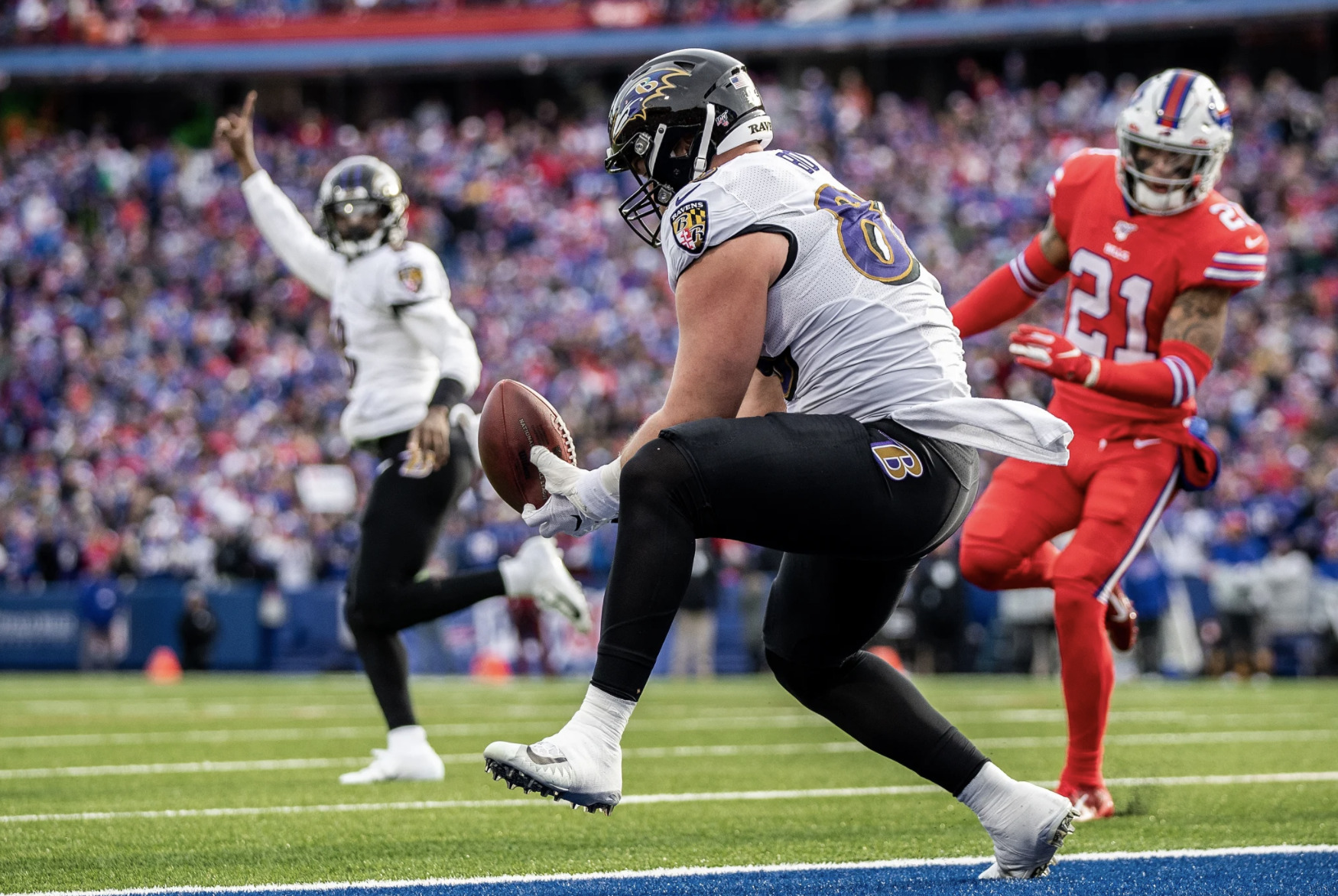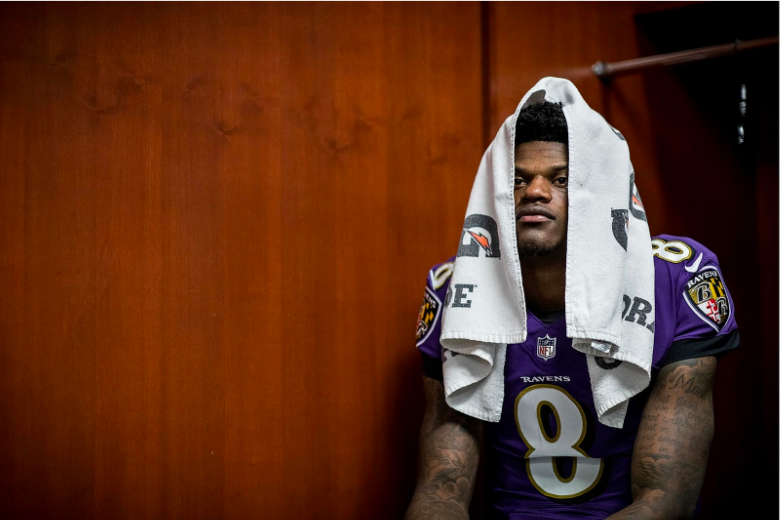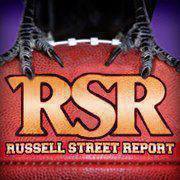Worse than Josh Allen. Worse than Baker Mayfield. Just a running back playing Quarterback. Can’t throw. Trash QB. Should-get-an-agent-because-agents-call-you-when-you-get-arrested-but-really-I’m-writing-this-article-because-agents-give-me-all-my-information-and-they’re-going-to-miss-out-on-millions-of-dollars.
My personal favorite was the “slower than Daniel Jones” take. If you don’t understand how the concept of average works, I’m recommending we don’t get involved.
#RavensFlock has done a masterful job defending Lamar Jackson this offseason against a torrent of terrible takes, which at times resembled a torch-wielding, angry mob, coming for your house.
There is little doubt that he is a generational, paradigm-breaking talent at the position, but he is polarizing.
While he may have been building Lamar up a bit in 2019, John Harbaugh reserved some of his most ardent praise for the new young leader of his team back then:
“I love the way you play. You just don’t flinch, you just attack. All you do is attack. You changed the game, man. You know how many little kids in this country are gonna be wearing number 8 playing Quarterback for the next 20 years?”
Harbaugh’s words ring true for many Ravens fans, but I know that many also feel that he hasn’t yet earned all of their admiration, after two straight early playoff exits before getting his first postseason win in 2020. By the way, I think he’d agree with you if you do feel that – Lamar responded to that Harbaugh quote by telling him that he’s got to get to the Super Bowl first.
It is in that context that we can rationally accept there are some areas of Lamar’s game that need to improve while also still appreciating what makes him great. So, RSR columnists Dev Panchwagh, Michael Crawford and James Ogden combine for another roundtable in the safe space of a Ravens fan site, where our takes can’t be used against us, to ask what makes Lamar great, but also what he can improve on and what we can expect from him in 2021 and beyond.
Where would you rank Lamar Jackson amongst NFL Quarterbacks?
Dev: It’s hard to place him outside of the top 5. Just look at his body of work over a two-and-a-half season sample size. He’s led his team to three straight postseason appearances, as a rookie in one of those seasons, in what seemed like a lost year. He won a unanimous MVP award in just his second season as the named starting quarterback in 2019. Pundits can talk about the playoff performances all they want to. But by any measure, if we’re just looking at his current resume over this timeframe, there is only one other QB who has achieved more individually and from a team standpoint during this time, and we know who that is.
Otherwise, I’d say he’s in that top 5-6 group along with the guy who doesn’t need to be mentioned, Russell Wilson, Aaron Rodgers, Tom Brady and Deshaun Watson. That’s the list. Any talk of Josh Allen needs to be contained to top 10 status until he shows what he can do after a near-MVP season. We know what Lamar can and has been able to do now over his starts.
James: I want to write about what Lamar means to this team, which Mike and Dev will expand on in later answers. When we say MVP, we forget that the middle letter stands for Valuable. Lamar Jackson is most certainly one of the top 5 most valuable quarterbacks to his team. Too often you see others who don’t watch this Ravens team week in, week out, credit the scheme above the player. In this case, more than most in NFL history, the player makes the scheme. The Ravens are able to take their offensive approach because of Jackson’s generational talent. I don’t understand when his value is adjusted down because of his athletic ability – that he isn’t that good a passer, his skills in that regard are enhanced by the stress his speed and elusiveness put on a defense. There’s some truth to that but why are we penalizing him for being better at something because of something else he is good at?
It might be because he breaks the mold in terms of Quarterback play, and that he’s hard to evaluate because of that. But if you’re still evaluating him against that standard, you need to actually break your mold.
Let’s let ourselves bask in Lamar’s greatness first – why is Lamar such a generational runner at the position?
Michael: Obviously he’s been blessed with amazing physical ability but there’s also a mental component to what he does as a runner that I don’t think gets enough credit. We’ve heard from defensive players and coaches about how fast Lamar is. Now think about moving at that speed while still processing what’s happening around you. The ability to see threats that could come from anywhere on the field out of your peripheral vision, setting up and evading 2nd or even 3rd level defenders, reading the leverage of defenders and using their momentum against them. All of that requires extremely fast mental processing as well as physical ability. I could go on and on but perhaps the best way to answer the question is to acknowledge that Lamar is a bad man!
Dev: He combines supreme physical ability and uncanny vision, like some of the great running backs in the game. First of all, he has insane footwork and balance. You see how he can stop and start to make defenders miss in the open field. But for a pretty long, wiry guy, you wouldn’t expect him to have that type of elusiveness. He kind of reminded me once upon a time of Randall Cunningham in his running heyday. Now I think there really is no comparison.
Then there is Lamar’s field vision and awareness. It’s almost like he has a sixth sense of where defenders are chasing him from. Intuitively as the quarterback, he has already scoped out the angles tacklers are coming from, but to be able to maintain that vision and those open-field instincts when the field shrinks is on another level.
In that sense, what I’ve seen from other great runners at the QB position is that they’re not necessarily looking to attack when they’re in the open field. They’re looking to make the most out of the situation and keep the drive alive. Lamar, on the other hand, legitimately understands that he can hit a home run every time he’s touching the ball. That ability and mindset combined strike fear in his opponents.
Is Lamar just a Running Back playing Quarterback?
(If you thought the answer to that would be yes, you’re reading the wrong article, so let’s re-frame – as a passer, what is Lamar good at and why?)
Michael: He has several qualities that make him a good passer. He has the arm strength, touch and accuracy (yes I said it!) to make any throw on the field. But the qualities that have impressed me the most are his decision making and poise in the pocket.
Paul Johnson, the former coach at Georgia Tech, Navy and Georgia Southern, whose offenses were known for their devastating option attacks, once said, “playing QB is decision making.” I think Coach Johnson was speaking broadly about QB play and not limiting it to passing, but you can see Lamar’s decision making as a passer in the way he takes care of the ball. Interceptions aren’t the only way to measure a QB’s decision making and I understand that all QBs attempt some throws that should’ve been intercepted but weren’t, either because the defender dropped the ball or for some other reason. But 23 interceptions over your first 41 starts (including four starts in the playoffs) is pretty darn good in my opinion. Those numbers are good enough for a 1.9% interception rate (% of times intercepted when attempting to pass) in the regular season and a 3.7% rate in the playoffs.
Poise in the pocket is something that can be difficult to quantify statistically but you can see it pretty clearly when you watch games. Out of the QBs drafted in the first round of the 2018 NFL Draft, Lamar unfairly received the label as a run-first QB from some in the media. When I studied him at Louisville, I saw the opposite. I saw a QB who was comfortable in the pocket, kept his eyes downfield and showed discipline working through his progressions. I’ve seen these same things as I’ve watched Lamar play in the NFL. Looking back at that 2018 draft, I’d argue the “run-first QB” actually had the most poise in the pocket of any of the QBs drafted in that first round.
James: Micheal has mentioned Lamar inside the pocket so let’s cover him outside the pocket (but not as a runner). He is a special off-platform thrower with enough gunslinger tendencies to make some absolutely ridiculous throws. He is an elite improviser and this doesn’t just show itself in his ability to turn seemingly impossible situations into long running gains, it’s also in his ability as a passer. As a passer on the run, he is outstanding, able to generate significant torque in his upper body without his feet under him to drive the ball downfield. As with his normal passing game, he throws with outstanding anticipation and makes ordinarily dangerous throws seem safe – his interception numbers back up that he protects the ball exceptionally well and some of these lower-percentage throws that seem ill-advised are actually calculated and carefully executed. He will vary his arm angles and release point, like a well put together Tampa Bay Rays bullpen, not just to keep the defense guessing but also because it’s the best way to get velocity on his throws in different situations. Sometimes this can prove to be a little inaccurate though (more on that later.)
This anticipation with his throws is possibly his second-best attribute as a passer next to the off-platform stuff, and it seems best deployed when he climbs the pocket or throws with a hitch, especially on touch and timing throws. When he steps into his throws, transferring his weight through his motion, most consistently done in these scenarios when he is moving forward in the pocket, he is unerringly accurate and throws into tight windows. He is at his best when throwing over the middle, often on intermediate throws into normal (not packed underneath) zone coverage, something he seems to carve up with relish. But he does flash the ability to do this to the sideline and in the compressed areas of the red-zone.
What do his traits and abilities mean for the Ravens’ scheme and how they attack defenses?
Michael: Greg Cosell of NFL Films has called the Ravens run game the most multi-dimensional run game in the NFL. Those multiple dimensions are a direct result of what Lamar can do with the ball in his hands. All offensive and defensive play calls contain assignments for each player. Those assignments can be executed using different techniques. Defensive players are taught to watch individual players and read keys. You can think of a key as an indicator that an offensive player gives to reveal what their individual assignment is and what the overall play might be.
One thing Lamar provides to the Ravens’ offensive scheme, is the stress he puts on all 11 defenders to stay disciplined and read their keys. It’s one of the reasons the Ravens’ QB-driven play concepts have been so effective. Defenders often take themselves out of position or even make it easier to be blocked by staring at Lamar. The Ravens have done a masterful job of exploiting this in the run game and I expect them to find more ways to do it in the passing game.
Dev: Jackson’s traits and abilities have transformed the Ravens’ scheme. There is just no other way to describe what he means to their offense and how they attack opposing defenses.
Foundationally, because Lamar is such a dominant threat as a runner, defenses must account for his ability to hurt them on the ground. That consideration alone has forced defenses to find funky ways to defend the Baltimore ground game. In a few instances, they’ve been able to bottle up Lamar and the running backs. But there is a cost associated with that and that means they are vulnerable through the air.
If a Defensive Coordinator chooses to play more of a zone scheme, just as Buffalo showed in the playoffs, defenses are exposed to being picked apart underneath. They can perhaps keep Jackson and the ground game contained, but as Lamar continues to evolve as a passer and has more weapons in his arsenal, it’s going to be difficult to defend him.

Chicken or egg? Is Lamar the reason for the success of the Ravens offensive scheme or is Lamar successful because of the Ravens scheme?
Michael: I know Lamar is the focus of this piece but I’d be remiss if I didn’t acknowledge the team as the reason for the success of the Ravens offensive scheme. Yes, the Ravens have designed an offense that plays to Lamar’s unique skill set. So in that respect, it would seem like the obvious answer to this question is that Lamar is the reason for their offensive success.
But Lamar said it best when he took over as the starting QB in week 11 of the 2018 season. A reporter asked him a question during the post-game presser that went something like this, ‘Lamar, how do you feel now that this is your team?’ Lamar responded in a way that displayed his leadership traits when he said, ‘This isn’t my team, it’s our team. I don’t block, I don’t catch passes, I don’t make tackles.’
Dev: It’s honestly an ideal match. Here’s an analogy that some people might appreciate. I could totally enjoy a peanut butter sandwich on its own. It can get the job done because peanut butter is that good. But adding jelly just puts the sandwich over the top and makes it an unstoppable combination.
Similarly, Lamar has enough ability to play well in most schemes. I firmly believe that. But the Baltimore offensive scheme, architected by Greg Roman and sponsored by John Harbaugh, really brings out the best in his game and provides the canvas to be a transcendent playmaker.
A lot of Roman’s critics believe the same scheme also shackles Lamar to being confined as a runner, and now it’s time to also play to his strengths as a passer. But he could have easily had it harder in other schemes, depending on which team had drafted him.
At least here in Baltimore, the coaching staff is devoted to building the offense around Lamar instead of the other way around.
If we were to block this section from view from the haters so they can’t use it against us, rationally, what do you think are Lamar’s areas for development?
Michael: I’ll defer to Lamar’s own words once again. Whenever he’s been asked this question, he’s answered by saying he can improve on everything. I know that sounds cliche but when I hear him say “I can improve on everything” what I hear is “consistency: doing everything it takes to play the QB position at a consistently high level.”
James: Consistency is most definitely the watchword for Lamar. When off-script, either rushing through his progressions or when first and second reads aren’t open but he doesn’t escape the pocket, the consistency of his normally excellent footwork eludes him and his throw can be inaccurate or lack velocity.
On a separate, slightly more controversial note, I do think he is also guilty of forcing throws downfield or to favored targets, especially as his deep accuracy can be sporadic at times. He looks for the big, ill-advised shot downfield while another receiver is running in space underneath with the potential to get significant yards after the catch. He will anticipate some receivers coming open and throw accordingly whereas with others he will need to see it, then throw it. This shows itself on several occasions when he could take what the defense is giving but tries to push the ball downfield. He will be hesitant and reluctant with his first read often. Most of this is seen when he is faced with complex and heavy underneath zones which have caused him trouble despite him being advanced at the cerebral parts of playing the position.
Dev: There are a few areas that I’d like to see him improve and it seems like he’s already baking in that development in this 2021 offseason. First, his footwork as a passer isn’t always consistent. Perhaps being devoted to the repetition and having a complete offseason program will help him maintain more consistent footwork so his accuracy doesn’t waver.
Also, one of the biggest areas I saw him regress in last season was his release. He was simply not on time as often as he was in 2019. In 2019, it just seemed like he was more decisive with his throws and decision-making.
In 2020, you could see a lot more hesitancy from him. You even saw it versus Buffalo in the playoffs. He would sometimes wait just a split second longer on a timing route and ultimately turn to his legs to make something happen. He also elected to take some shorter completions or even run with the ball at times during the season instead of airing it out downfield.
With a more dynamic group of receivers, and what appears to be a better group of pass blockers in front of him, hopefully he’ll get back to letting the ball go decisively in 2021.
Lastly, I also want to see Lamar continue to improve his decision making when he’s out of the pocket. He took some strides last year as a dangerous off-script passer when the pocket would break down and he had to go on a scramble drill. That’s the part of the game that Wilson in Seattle has really nailed down, and I can see Lamar taking similar steps forward as an out-of-the-pocket marksman.
What do you think were the reasons for the statistically down year from the former league MVP, that were outside of his control?
Michael: Where to begin. I think you have to start with the Covid shortened off-season. OTA, mini-camps, training camp and the preseason are such an important time for teams and especially young players, even one coming off a league MVP season. I’d also look to the offensive line. After Ronnie Stanley’s injury, we saw a musical chairs sort of situation that extended throughout most of the season. We know it all starts up front with the offensive line and when you lose starters, have guys playing out of position and coming in and out of the lineup, it’s a real challenge to be consistent on offense.
James: First things first – context. Something I do not see mentioned at all when anyone talks about Lamar last season – he reportedly strained his patella in early October prior to the Bengals game. He didn’t miss any time, and this was likely a minor injury but it may have only been his COVID break, later in the season, that allowed him to get fully healthy for the stretch run. We all know the run of MVP-level games he broke off after missing the second Steelers game due to COVID, and I have to wonder whether the injury played a part in his early season form.
Michael mentioned the Stanley injury and Dev has spoken before about the importance of the loss of Marshal Yanda (I couldn’t agree more with him). If Jackson’s mechanics can be inconsistent at times, the one thing you don’t want is pressure up the middle. The revolving doors that ended up replacing Yanda (bit harsh but I’m talking about the drop-off from the Hall of Famer, and it felt dramatic) meant Lamar was often unable to step into his pocket throws and ended up inaccurate. This undoubtedly affected him as the pressure was more consistent through arguably the most important spot on the line for disrupting an on-schedule, inside-the-pocket pass.
Did Lamar regress in any part of his play from last year and what areas for development were particularly on show in 2020?
Michael: You could certainly look at certain stats and make the regression case. Lamar’s Yards Per Attempt (YPA) dropped slightly from 7.8 in 2019 to 7.3 in 2020. He threw three more interceptions, had 10 fewer TD passes, and his completion percentage dropped from 66.1% to 64.4%. But I’m not a big numbers guy. I prefer to look at his 2020 season through the lens of a growth experience. You can look at individual game situations and see areas where he showed improvement from 2019 and also find areas he can learn from.
I think the word regression in the context of player performance can miss a key aspect of development: it’s not always linear. By that I mean we tend to see player performance as always moving in one direction – up. Picture a line graph. In my opinion, development looks more like a zig-zag line than a straight line. Sometimes the line goes up, other times it goes down. That said, I think the overall trend over Lamar’s first three seasons is an upward one. Ask yourself this question: how do we learn things? We make mistakes, right? Those mistakes create the opportunity for correction, for us to learn and grow.

What did we see from Lamar at Louisville that can give clues to his future trajectory with the Ravens?
James: Let’s first remember something that was mentioned a lot by smart analysts when he came into the league but I don’t hear as often anymore: Lamar played in a Bobby Petrino pro-style offense at Louisville. He did everything there that you would need him to do at the next level. I felt comfortable projecting him to success in the NFL because you had enough evidence of him doing the things you needed him to do at the next level. Some of the criticism of him that off-season, leading up to the draft, seemed to me like lazy opinions.
Although he earned a Heisman trophy during his Sophomore year, we actually saw him lead the FBS his Junior season with an average of 405 total yards of offense individually per game. 405 individual yards. Let that sink in for a minute – against good ACC competition he climbed to unheard-of heights of production.
My point is: Lamar kept getting better. He has done this over his entire career. It’s what makes me most excited for his future years in the league – I still don’t think he’s reached his potential, perhaps not even in his MVP year.
Dev: The pocket passer identity in Lamar as the quarterback at Louisville is what should stick with him throughout his career in Baltimore. It’s ingrained in him, more than the highlight reels he puts out there as a runner.
However, he has a comfortable and serene pocket game. You can see that part of his game evolve as he counts on his arm more and more. I hate to keep making comparisons, but back to the Cunningham one. Once Cunningham started to put together his pocket game in Minnesota, he was a prolific passer and you could see the full passing game take flight. I can easily see that happening for Lamar in a much quicker timeframe.
What can we expect from Lamar in 2021?
Michael: Fire! Absolute Fire! No seriously, that’s what I expect. Give Lamar some stability and continuity on the offensive line, combined with the talent he has in the backfield and in his group of pass catchers, I think we could see something really special in 2021.
Dev: I see no reason why he can’t put together another MVP type season. What that means from a statistical standpoint, I’m not sure. I could easily see him putting up fewer rushing yards, touchdowns, and splash plays in favor of more check downs that lead to touchdowns from guys like J.K. Dobbins and Marquise Brown in the open field.
Lamar has now had an entire offseason to take a step back from a COVID shortened year following an MVP campaign. In any regular offseason with a defined structure, it would have been difficult for a QB to measure up to expectations, let alone with no real offseason.
Say what you want about the types of weapons and offensive linemen that the front office targeted, no one can realistically knock the staff for not making a real effort to surround Jackson with much better talent overall. From a coaching standpoint as well, the staff has been augmented, and it’s clear that Lamar is putting in time on his mechanics and accuracy.
If everything comes together and this offense can stay healthy, it’s going to be a major bounce-back for him in 2021.
James: Growth. He is relentless in his pursuit of a Super Bowl and it seems to me that he thinks the main vehicle to get there is getting better himself. I expect him to be better and more consistent than he was last season. Perhaps not statistically better, but I expect this to be his most effective year, his most valuable year to the team.
I also expect to see him continue to be more of a leader for this team. There is an example from last year that I love to cite in terms of his leadership of the offense. There were times when he was let down by his Wide Receivers. On a comeback route that resulted in an interception against Washington, Miles Boykin puts a less-than-friendly-to-your-quarterback break at the top of his route and Kendall Fuller picks the ball off. The next part of it was lost because that was the last play before the end of the half, but the very next offensive play at the start of the second half, Jackson targets Boykin in a premeditated fashion for a completion. This could have been play design or play-caller instruction but I think it was Jackson deciding to go back to a guy who’s confidence must have been low, or at least there was little hesitation in going to his first read if it was Boykin. I love this about Jackson and I think it’s an underrated part of the value he brings to this team.
His leadership isn’t the likes of which we’re used to in Baltimore, given how gregarious and vocal #52 was. But not all inspirational leaders look like that, and players gravitate towards Jackson, galvanized by his leadership. I expect the Ravens to take another trip to the Super Bowl with Jackson as the leader within this team. Maybe not this year, as that doesn’t just depend on him, but he’ll get there.










